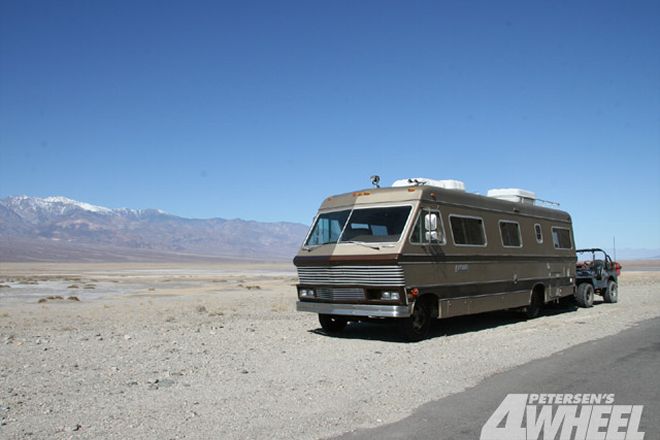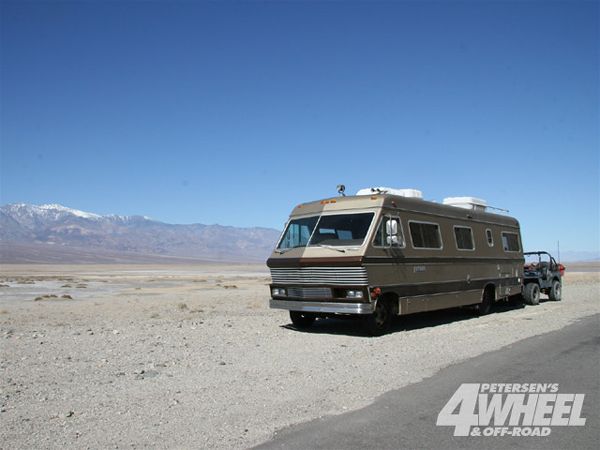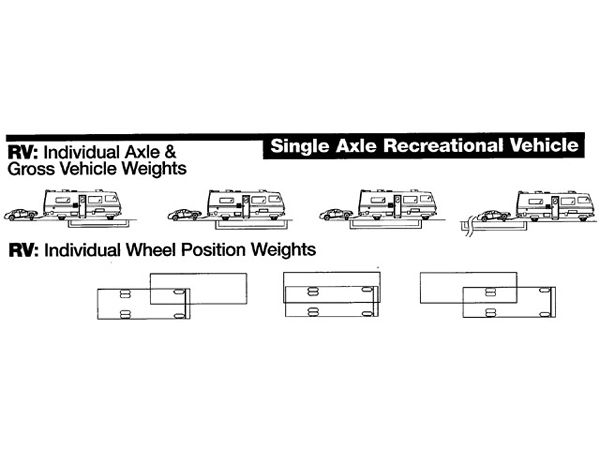
 LIQUID WEIGHTS
LIQUID WEIGHTSTrue off-roaders sometimes get so caught up in their rigs' shoes that they back-burner the rubber that meets the road. Trailer tires are often an afterthought-until they fail. In other words, appropriate funds go toward Boggers, Krawlers, Claws... Whatever's left gets spent on tow-rig tires. One blowout easily undermines this thought process. Add a trailer and tow vehicle behind a blown-out tire, and things can get ugly.
The goal with this article is to determine proper tire pressures for tow vehicles, specifically motorhomes, and look at other aspects of safe load-carrying. (Many of the tips also apply to dualies and even to medium-duty tow rigs.)
Weighing In
To find out what you need, you first need to find out what you have. This involves weighing the RV. Just as being overweight taxes the human body's organs and joints, an overloaded tow vehicle takes its toll on tires and mechanical parts.
To find a scale, look in the Yellow Pages. Businesses that have certified scales include moving/storage companies, gravel pits, and truck stops. Call ahead to explain what you need and make an appointment. Load the RV with your normal rations of people, supplies, water, gas, propane, and gear, then attach your trailered load before going to the scales.
Plan on spending at least 30 minutes on the scales. You'll need to weigh the overall vehicle as well as its front and rear halves, each side, each corner, and the loaded trailer. Compare the scale's numbers to those on the vehicle's Federal Dataplate placard. Any corner that weighs more than half of its rated Gross Axle Weight Rating (GAWR) is overloaded-even if the sum of both sides is under the GAWR. Ideally, you should redistribute the load and reweigh until it's under the GVWR and allocated as even as possible. A balanced load makes steering and braking more predictable and also extends component life.
Pressure
The double-whammy: loads that exceed the manufacturers' ratings combined with tires that don't have a high enough load rating. Assuming that total weight is under the GVWR, look at the tires. If their maximum load ratings (usually stamped into their sidewalls) don't exceed their respective corner's loaded weights, the tires should be replaced with higher-capacity ones.
Most wheelers know the importance of proper tire pressure. Still, a Bridgestone/Firestone sampling found that 80 percent of RVs have at least one underinflated tire-often an inner dual. As most people now know from extensive media coverage, underinflation increases friction, which generates more heat, which can eventually cause a blowout. Normal pressure loss is 1-2 psi a month.
Since the vehicle literally rides on air, pressure is critical. The higher the pressure, the heavier the load that can be supported. Proper pressure begins with the manufacturer's recommendation as listed on the placard in the vehicle. Never run less than this. Next, refer to the tire's sidewall for the maximum inflation pressure. Never exceed this-overinflated tires are more likely to be damaged by sudden impacts.
To narrow down the proper pressure, refer to the manufacturer's load and inflation table for your tires. This lists the minimum pressure needed for various load weights, for both single and dual tire applications. Verify that you can safely run high enough pressure to support your loaded vehicle-and that said pressure doesn't exceed your wheels' maximum-inflation recommendation. Also, every tire on an axle should have the same pressure. When in doubt about any of this, consult a good tire store or RV shop or refer to the sources listed at this article's end.
Now for the most important part: Check pressure at least weekly with the tires cold-three to four hours after driving or before driving a mile. Never rely on visual sidewall-bulge inspection. Always use a quality pressure gauge: double-angle models are easiest on RVs.
 Firestone's How to Weigh Your Travel Trailer or RV brochure is available at Firestone's MasterCare Tire Centers and at www.trucktires.com. It has worksheets for weighing many dual and multiple-axle towing setups.
Firestone's How to Weigh Your Travel Trailer or RV brochure is available at Firestone's MasterCare Tire Centers and at www.trucktires.com. It has worksheets for weighing many dual and multiple-axle towing setups.
Age
In addition to improper air pressure, tire age can also lead to failure. To learn when a tire was made, consumers can decode the DOT manufacturing stamp on the sidewall: a two-digit number for the week of the year followed by the two-digit year. European automakers recommend replacing any tire that's more than 6 years old; domestic tiremakers don't concur, explaining that new tires can sit in warehouses for two or more years prior to sale.
Age generally isn't a concern on commuter vehicles-the tread usually wears out before it separates and fails. Age is more of an issue on infrequently used tires: RVs, collector cars, and spares. The tread might pass the penny test, but the tire could be rotting from the inside out.
Stems and caps also deserve attention. Rubber stems aren't rated for higher inflation. All-steel, clamp-in stems are worth considering-especially if you have dualie extension hoses. Also, make sure that dualie valve stems are clocked 180 degrees apart to make pressure-checks easier. For caps, consider sealed metal models to keep out dirt and water.
Two old standbys-wheel alignment and tire rotation-extend rubber life. Uneven wear and improper tracking indicate a problem. Assuming that tire pressure is correct, take a trip to a tire store or repair facility that knows RVs. Also, any tire that's discovered to be 20 percent underinflated should be professionally inspected. This involves unmounting the tire to check for internal damage.
The underlying message: Don't devote all your tire attention to your trail rig. Your tow vehicle's tires are important too. The keys to safe towing with an RV include not overloading the rig, evenly distributing the cargo, matching the tires to the tow vehicle, and maintaining the tires by checking pressure and wear. The sources here have detailed information for specific vehicle configurations and scenarios, such as mixing radial and bias-ply tires, load ranges/ply ratings, and more.









